#offshore patrol vessel
Explore tagged Tumblr posts
Text
India signs $73 million deal with Bharat Electronics for navy target detection system
By A Correspondent New Delhi: India’s Ministry of Defence on Feb. 8, 2025, signed a contract with state-run Bharat Electronics Limited to buy 28 target detection systems for its naval ships. The EON-51 systems for 11 New Generation Offshore Patrol Vessels and three Cadet Training Ships are worth Rs 643.17 crore (~US$73 million), and this purchase would be done under the Buy (Indian –…
#Bharat Electronics#Bharat Electronics Limited#Cadet Training Ship#DAP#Defence Ministry#Defense#Electro-Optic#Fire Control System#IDDM#India#Indian Navy#Maritime#Military#Ministry of Defence#Navy#New Generation#Offshore Patrol Vessel
0 notes
Text
Global Offshore Patrol Vessels Market Is Estimated To Witness High Growth Owing To Increasing Defense Expenditure
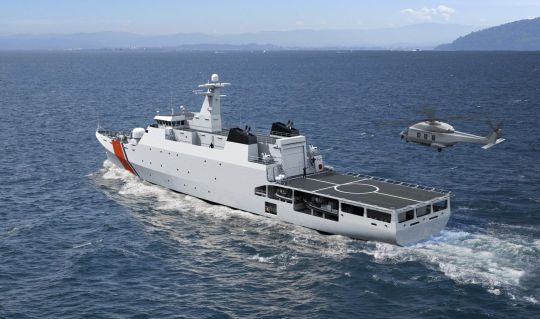
The global Offshore Patrol Vessels Market is estimated to be valued at US$ 15.53 billion in 2022 and is expected to exhibit a CAGR of 4.1% over the forecast period 2023 to 2030, as highlighted in a new report published by Coherent Market Insights. Market Overview: Offshore patrol vessels are naval ships primarily used for patrolling and policing coastal boundaries. These vessels play a crucial role in safeguarding a country's maritime environment, protecting its offshore assets, and ensuring the safety of its waters. Offshore patrol vessels offer several advantages such as enhanced surveillance capabilities, versatility in missions, and cost-effectiveness compared to larger naval vessels. The need for these vessels is driven by the increasing defense expenditure of countries, rising maritime threats, and the need for effective border control. Market Key Trends: One key trend in the offshore patrol vessels market is the integration of advanced technologies for enhanced surveillance and defense capabilities. This includes the adoption of unmanned aerial vehicles (UAVs) for aerial surveillance, advanced radar systems for target detection, and improved communication systems for real-time data sharing. For example, Damen Shipyards Group N.V. has introduced the Damen SWORD-17, an offshore patrol vessel equipped with advanced technology for increased situational awareness and operational efficiency. PEST Analysis: Political: The political environment plays a crucial role in the offshore patrol vessels market. Government policies and regulations related to maritime security, defense spending, and international collaborations impact the demand for these vessels. Economic: Economic factors such as GDP growth, disposable income, and trade activities influence the defense budget allocated for offshore patrol vessels. Economic stability and growth drive investments in naval capabilities. Social: Social factors such as increasing concerns over maritime terrorism, drug smuggling, illegal fishing, and piracy drive the demand for offshore patrol vessels. These vessels help in maintaining the safety and security of coastlines, protecting natural resources, and safeguarding international waters. Technological: Technological advancements in the field of maritime surveillance, communication systems, and propulsion technologies are driving the growth of the offshore patrol vessels market. The integration of advanced technology enhances the operational capabilities of these vessels. Key Takeaways: 1: The Global Offshore Patrol Vessels Market Size is expected to witness high growth, exhibiting a CAGR of 4.1% over the forecast period, due to increasing defense expenditure. Countries are investing in modernizing their naval fleets and strengthening their maritime defense capabilities. 2: In terms of regional analysis, Asia Pacific is expected to be the fastest-growing and dominating region in the offshore patrol vessels market. This can be attributed to the rising maritime disputes, territorial conflicts, and the need for maritime security in countries such as China, India, and Japan. 3: Key players operating in the global offshore patrol vessels market are Austal Ltd., BAE Systems plc, Damen Shipyards Group N.V., Dearsan, Fincantieri S.p.A., Fr. Fassmer GmbH & Co. KG, Fr. Lürssen Werft GmbH & Co.KG, Garden Reach Shipbuilders & Engineers Limited, Israel Shipyards Ltd., and Naval Group. These companies are focusing on product innovation, strategic collaborations, and mergers to strengthen their market presence. In conclusion, the global offshore patrol vessels market is poised for significant growth due to increasing defense expenditure and the need for maritime security. The integration of advanced technologies and regional dominance of the Asia Pacific region further contribute to market expansion. Key players in the market are constantly striving to stay competitive by investing in research and development initiatives.
#Offshore Patrol Vessels Market#Offshore Patrol Vessels Market Growth#Offshore Patrol Vessels Market insights#Offshore Patrol Vessels Market values#Offshore Patrol Vessels Market analysis#Offshore Patrol Vessels Market outlook#Offshore Patrol Vessels#territorial waters#maritime resources#surveillance systems#military standards
0 notes
Text

Northern lights flare above a Royal Canadian Navy offshore patrol vessel
214 notes
·
View notes
Text
In its fortieth year, Israel remains in a state of war with several Arab neighbors. That is bedrock. It must never be forgotten in discussing the Land and the Faith. No guns are going off as I write, in March 1987, but formal hostilities exist with no end in sight. The Jewish populace has grown in forty years from half a million to more than three million. The Israel Defense Force has become a military power without peer for its size; considered comparable, in some aspects of tactics and technology, to superpower forces. That is probably way the guns are not firing at the moment.
Since I wrote "The Ashes and the Gold" in 1969, the remarkable chronicle of the Jewish State has been punctuated by further military exploits The brilliant but scary and very costly turnaround victory in the Yom Kippur War of 1973, the airborne rescue of hostages from Arab terrorists at Entebbe in 1976, the controversial expulsion of the PLO terrorists from Lebanon, the surgical bombing of the nuclear reactor in Iraq, the air strike on the terrorist headquarters in Tunis; such high combat drama has repeatedly made world headlines.
The Israelis would gladly trade all that adventure and glory for peace. They have proved it. I was present at the lowering of the flag at the Sharm El Sheikh naval base in April 1982, a final step in their peaceful evacuation of the Sinai peninsula, under the Camp David agreement. A son of mine was serving in a Wasp patrol boat based there. After the ceremony I sailed with him up the Red Sea to Eilat, the new base for his vessel, having witnessed the most impressive sacrifice for peace made by a nation in modern times. I will never forget the sight of his Wasp squadron, circling around and round full speed offshore with sirens eerily wailing, in the farewell ceremony for a lost ship; nor the ranks of girl soldiers in white dress uniform on the wharf, standing at attention and weeping as the Star of David flag came down. Egypt lost the war to regain Sinai by force of arms. The Israelis gave back this strategic buffer of their own accord, to fulfill their part of a breakthrough peace on one front.I once asked an Israeli general how it was that his tiny new nation had so swiftly acquired remarkable military prowess. He replied, "We had to." That is the long and the short of it. The oil-rich Arabs can buy all the weaponry they require from other countries, mainly the Soviet Union. The Israelis have to build their own tanks, and much of their defense materiel. So they have learned to make armaments, and to excel in advanced technology, scientific and agricultural as well as military, for one and the same reason: they have had to.
- This Is My God, Herman Wouk, page 273-274
#this is my god#herman wouk#jumblr#frumblr#israel#israeli history#history#jewish history#antisemitism
55 notes
·
View notes
Text


Three cheers for HMCS Max Bernays! Our third Arctic and Offshore Patrol Vessel was commissioned into service in North Vancouver yesterday. HRH, The Princess Royal presented the commissioning pennant in her role as Commodore-in-Chief, 🇨🇦Fleet Pacific. #HelpLeadFight
@RoyalCanNavy | 4 May 2024
32 notes
·
View notes
Text
The Princess Royal visits British Columbia, Canada.
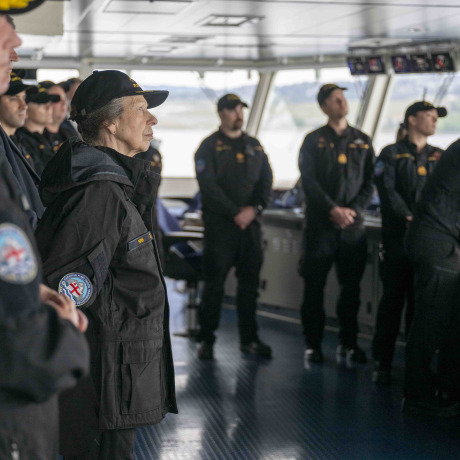
As Commodore-in-Chief of the Canadian Fleet Pacific, Her Royal Highness The Princess Royal, accompanied by Vice Admiral Sir Tim Laurence, has been in British Columbia for a series of engagements with the Royal Canadian Navy.
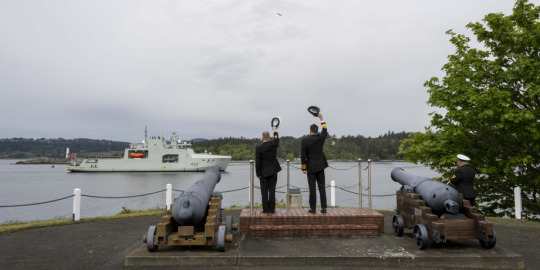
Upon arrival in Canada on Friday 3rd May, The Princess Royal attended the Commissioning Ceremony for the HMCS Max Bernays – the Canadian Pacific Fleet’s first Arctic and Offshore Patrol Vessel. The Princess Royal also had an opportunity to tour the ship and meet some of its company.
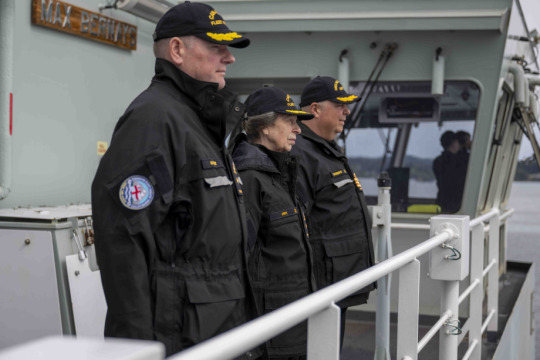
The following day, on Saturday 4th May, Her Royal Highness laid a wreath at God’s Acre Cemetery as President of the Commonwealth War Graves Commission. The historic cemetery, in Esquimalt, is the final resting place of more than 2,500 military personnel and their families.

Next, The Princess Royal visited the Maritime Museum of British Columbia Archive to view some of the items in its archival collection.

After learning that there was no naval museum during a visit to Esquimalt in 1951 by the then Princess Elizabeth and Prince Phillip, Prince Philip contacted the Greenwich Maritime Museum and asked them to send some objects to British Columbia to start a new naval museum thus creating the Maritime Museum of British Columbia.

The Princess Royal also visited FED Urban Farm to hear about their work in providing home-based start up food gardens during the Pandemic which used simple and affordable supplies.

On Sunday 5th May, The Princess Royal and Sir Tim Laurence attended the Battle of the Atlantic Memorial Parade. The Battle of the Atlantic was the longest continuous battle of the Second World War and the Parade commemorates the service and sacrifice of the thousands of Canadians who fought for control of the North Atlantic Ocean to supply the war effort from 1939 to 1945.
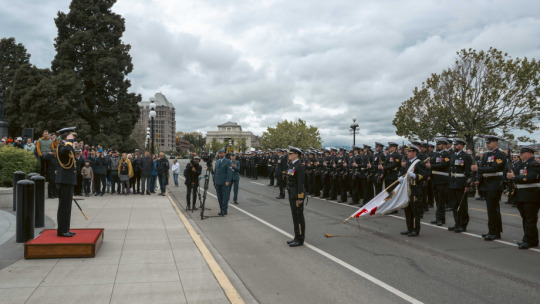
© Royal UK
#NOT EVERYTHING WAS MENTIONNED BY THESE FUCKERS#IDK WHY#UGH#princess anne#princess royal#tim laurence#timothy laurence#brf#british royal family#workanne
33 notes
·
View notes
Text
[ffxivwrite2024] prompt 1: steer
D’zinhla had been on enough vessels to know that danger lurked just offshore.
The fact that large vessels were unable to come to the piers of Tuliyollal made sense to her long before the shoals came into view. Or the evidence of them; the waters themselves were dotted with a few exposed rocks, but the shoals were not directly visible, not from this distance, not in this angle of sun. It was more about the darkening of the water, the way the waves moved over them, subtle signs of the danger they represented.
A formidable barrier for the coastal city, protecting them from seagoing raiders. She wondered if that had ever been a concern in the city’s history; her knowledge of Tural and its peoples was sparse, and lacked any mention of piracy, so she could hardly be sure one way or the other.
Protection, perhaps; but the shoals were also providing a significant barrier to entry for peaceful sea travel. She had no doubt that stout merchant vessels, riding low to the waterline with cargo holds full of goods, wouldn’t dare risk venturing past them, but that would mean anchoring well offshore, and depending upon smaller vessels to ferry those goods back and forth. She could already see some of those small vessels in the distance, putting out from the piers to meet the ship from western waters.
Their own conveyance was being prepared, and D’zinhla shifted the pack on her shoulders, feeling a tingle of impatience to get ashore. Not even the thought of putting a line into the waters to see what fish patrolled the edge of the shoals could distract her from that. Well, not too much; she did make a note to pay her way onto a fishing vessel later, when she had the time.
She heard and felt Airraim’s low chuckle behind her, and her ears perked appreciatively at the sound as she glanced back. Her beloved was smiling at her, golden eyes bright. “Eager to begin your new adventure?” Airraim asked.
She laughed, tilting her head. “I’d think it’d be more surprising if I was not!”
“True enough, my heart,” Airraim acknowledged with her own headtilt. “I suppose you’re already imagining the fish you could catch here.” She then laughed as Zin flushed.
“Guilty,” she admitted, unable to feel too abashed. “I know, I know, we’ve a lot to do beforehand, and likely some statecraft to acknowledge, what with attending an important personage, but it can’t hurt to think about the fishing!”
“Because that’s more pleasant than the statecraft, I know,” and Airraim rested a hand on her shoulder. “Don’t worry, I’ll pay close mind to it, in case yours has drifted to sea from the drone of diplomatic niceties.”
Now she did feel embarrassed, a little bit, because it was clearly her responsibility to become informed about what it was she and her fellows had agreed upon when they took up the invitation from Wuk Lamat.
Before she could say as much, Airraim had continued. “And I’m certain that Alphinaud and Krile will be listening closely themselves, saving you and Alisaie the additional effort.”
She flushed, but couldn’t argue that she was more inclined to Alisaie’s action-oriented disposition than Alphinaud’s careful consideration of interpersonal issues.
“You know we’ll help you put your foot right. Or at least, not straight into it,” her beloved added, with a smirk that Zin could hear.
She sighed and leaned back; the pack she wore prevented her from directly leaning into Airraim, dammitall, but the feeling of contact was there. “I do appreciate it, Airraim.”
“I know. Now, come on, it looks as if our ferry is ready.”
Gladdened by the reassurance that she wasn’t solely responsible for charting their course, D’zinhal rocked her weight forward to the balls of her feet, preparing to take her first steps into the new adventure that awaited. Just as soon as she got to land.
10 notes
·
View notes
Text
Armchair military enthusiasts can only cause a nuclear cacophony
By N. C. Bipindra As a rookie in journalism three decades ago, the first lesson given to us by our seniors and editors was that ‘Dog bites man is not news, but man bites dog is, and that is a goldmine.’ Many of us, who have transitioned from print to electronic media and now social media journalism, have learned that such sensationalism may not always accrue benefits. While in the short term,…
#Arihant#Defence#Defense#Dhanush#FAS#India#Indian Navy#INS Subhadra#INS Suvarna#International Yoga Day#Maritime#Military#Missiles#Naval#Navy#Nuclear#Offshore Patrol Vessel#Open Source Intelligence#OPV#OPVs#OSINT#Seychelles#SSBN#SSBNs#Submarine#Yoga
0 notes
Note
Well uk has send a small warship to the coast of Venezuela and guana

I mean, calling an Offshore Patrol Vessel a "warship" it's a bit overkill, but yeah, they really are sending help for Guyana.
Good for them, don't let Venezuela get away with stealing 70% of Guyana!
15 notes
·
View notes
Text
Lula in China: The End of Brazil’s Flirtation With the Quad Plus
The new Lula administration has brought Brazil’s China policy back in line with its traditional approach, after the anti-China rhetoric of Jair Bolsonaro.

In 2018, Chinese Foreign Minister Wang Yi dismissed the idea of the Quadrilateral Security Dialogue (Quad), formed by the United States, Japan, India, and Australia, asserting that it would “dissipate like sea foam.” The Quad, created to facilitate the convergence of the four countries in terms of policies toward the Indo-Pacific, not only proved to be resilient over time but also intensified its activities in the region under both former U.S. President Donald Trump (2017-2021) and current President Joe Biden. During this period, the consultation between the group members went from being a biannual foreign ministerial dialogue to head of government-level consultations.
Analysts introduced the term Quad Plus in 2020 to describe a minilateral dialogue of states that extends the Quad beyond the four lynchpin democracies. However, while the term “Quad Plus” is not officially endorsed by Washington, Canberra, New Delhi, and Tokyo, it has become shorthand for non-Quad members that are closely cooperating with the group. That list includes other important U.S. partners such as Brazil, South Korea, Vietnam, Israel, New Zealand, and France. The idea originated during the uncertainty and global tensions at the time of the outbreak of the COVID-19 pandemic.
The first concretization of the Quad Plus framework took place on March 20, 2020, when then-U.S. Deputy Secretary of State Stephen Biegun proposed a Quad meeting including Vietnam, New Zealand, and South Korea, which aimed to enable an exchange of assessments of the national pandemic situation of participant nations and align their responses to contain its spread. Later, a foreign ministers-level meeting in May 2020 with the participation of Israel, South Korea, and Brazil consolidated the Quad Plus with a global outlook. The extended initiative also materialized for the first time in the security realm in April 2021, when France led the La Pérouse Naval Exercise in the Bay of Bengal.
The unstated motivation of the Quad is the shared concern among the four original members about the rise of China’s international political and economic clout and the desire to check Beijing’s increasing military activities in the South and East China Seas. At the time, Brazil seemed to share such wariness in relation to Beijing since it was under the Jair Bolsonaro administration (2019-2022). The far-right former Brazilian Army captain aligned the country’s foreign policy to Washington’s interests. Bolsonaro also embraced fierce anti-Chinese rhetoric due to his distaste for Communism and China’s growing investments in sensitive Brazilian sectors like agriculture, meatpacking, and mining. Bolsonaro insinuated that China had engineered the COVID-19 virus and purposefully spread it worldwide to benefit from the pandemic economically.
Despite contentious relations with the East Asian power, Brasília failed to concretize a rapprochement with the Quad. It happened for three main reasons. First, Brazil is clueless about the Indo-Pacific. It lacks a full-fledged long-term strategy toward the region and has failed to include the very term “Indo-Pacific” in its official vocabulary. Brazil’s geographical position, facing the South Atlantic Ocean, and its limited capacities of naval power projection beyond marginal seas make it unlikely that Brasília will be able to ensure the freedom of navigation in a region half a world away. For example, among the last seven IBSAMAR Naval Exercises, carried out with India and South Africa, Brazil deployed an offshore patrol vessel to Goa only once.
Continue reading.
6 notes
·
View notes
Text

Helm of Italian offshore patrol vessel ITS Francesco Morosini (P431).
11 notes
·
View notes
Text
Diciotti-class offshore patrol vessel
ur government assigned gender for the day is the first thing u get when u click this link to a randomised wikipedia article. NO REROLLS . i am the trollsteineggje mountain in norway
125K notes
·
View notes
Link
0 notes
Text
Royal New Zealand Navy to reactivate OPV while awaiting fleet modernisation
17th February 2025 - 10:53 GMT | by Chen Chuanren in Singapore

HMZNS Otago will be temporarily reactivated following the loss of HMNZS Manawanui. (Photo: New Zealand Defence Force)
HMNZS Otago will perform the duties of the written-off HMNZS Manawanui until an upcoming renewal process is completed.
Most Viewed
Most Shared
Royal New Zealand Navy to reactivate OPV while awaiting fleet modernisation
Royal Navy’s Type 31 frigate to use half the crew of the Type 23 and embrace automation
Saab relaunches third upgraded Gotland-class submarine
IDEX 2025: Saab launches new Coast Control Radar to protect waterways
The Royal New Zealand Navy (RNZN) will reactivate the offshore patrol vessel (OPV) HMNZS Otago to temporarily fulfil the duties of HMNZS Manawanui.
Manawanui was the navy's sole dive and hydrographic vessel, which ran aground and was written off in November 2024.
RNZN chief Rear Adm Garin Golding told Shephard in Singapore that some of the Manawanui's crew will be assigned to Otago while it is used for patrol and maritime domain awareness duties.
Related Articles
NZ navy’s hydrographic vessel arrives home
NZ navy receives three Littoral Manoeuvre Craft
Royal New Zealand Navy loses first vessel to the sea in 80 years
Golding explained: “The reality is that the fixed diving and surveying on the Manawanui are not capabilities that we’ll be able to replicate in the current fleet. We do have detached and expeditionary capabilities, both in diving and hydrographic areas, that we’ll be able to deploy off our existing ships, and we’ll just need to be innovative how we get there afterwards, until the Defence Capability Plan provides options going forward in that regard.”
Otago currently holds so-called ‘care and custody’ status, and is in storage due to the RNZN's inability to crew all of its ships.
The navy now operates eight ships in five different classes, which Golding described as ‘challenging’ to operate, train, maintain and sustain.
As all but one vessel, the tanker HMNZS Aotearoa, are due to reach the end of their operational life between 2032 and 2036, and there is an opportunity under the Naval Fleet Renewal process to streamline the fleet.
Under this process, which will be considered by the NZ government, interoperability with Australia and other partners will also be examined.
“We’ll look to see if they have applicability to what we’re after for our size. Our navy is slightly different to that of Australia, for example. So we need to make sure that it’s fit for purpose,” Golding explained.
He also dismissed the possibility that the RNZN could take in decommissioned Anzac-class frigates from Australia for spares, as the commonality benefits have shrunk after the two countries embarked on differing upgrade paths.
Golding was in Singapore for an introductory visit where he affirmed the RNZN’s commitment in the region and confirmed that HMNZS Aotearoa will participate in the Five Powers Defence Arrangement exercise towards the end of 2025.

Author
Chen Chuanren
LinkedIn
Chen Chuanren is Shephard’s Singapore correspondent, covering primarily land and sea systems. He served in …Read full bio
Share to Facebook X Linkedin
0 notes